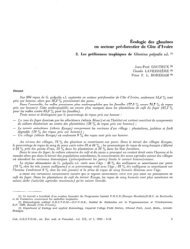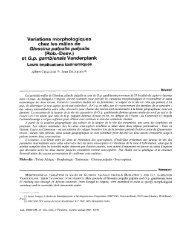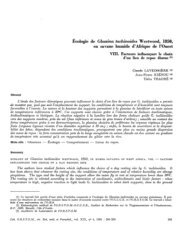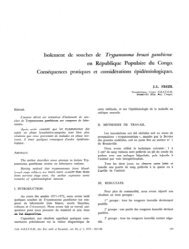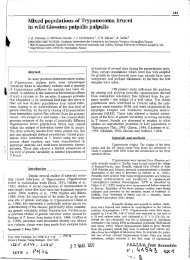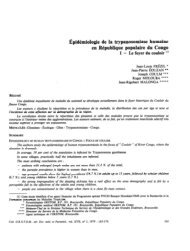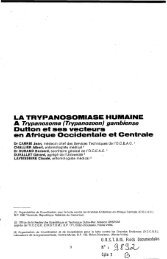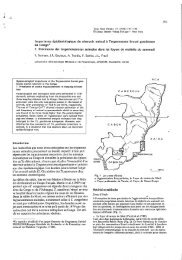Genetic and Morphometric Evidence for Population Isolation of ... - IRD
Genetic and Morphometric Evidence for Population Isolation of ... - IRD
Genetic and Morphometric Evidence for Population Isolation of ... - IRD
You also want an ePaper? Increase the reach of your titles
YUMPU automatically turns print PDFs into web optimized ePapers that Google loves.
September 2006 CAMARA ET AL.: ISOLATION OF A TSETSE POPULATION 857<br />
Fig. 4. Regression <strong>of</strong> Þrst discriminant factor on centroid<br />
size. Vertical axis is the DF1, representing 84% <strong>of</strong> the total<br />
discrimination. Horizontal axis is the centroid size <strong>of</strong> the<br />
wing, in pixels. White squares, Loos (L); black squares, Magnokhoun<br />
(M); <strong>and</strong> gray squares, Touguissoury (T). Regression<br />
line is shown.<br />
Results<br />
Entomological Surveys. Of 421 tsetse (240 M, 181 F)<br />
that were trapped during the survey, all were G. p.<br />
gambiensis based on morphological characters <strong>and</strong> on<br />
geographical distribution. The apparent density (AD)<br />
averaged 4.53 tsetse per trap per day. On Loos isl<strong>and</strong>s,<br />
26 tsetse in total were caught (AD <strong>of</strong> 1.44 tsetse per<br />
trap per d), 277 were caught at Magnokhoun (AD <strong>of</strong><br />
6.15 tsetse per trap per d), <strong>and</strong> 118 at Touguissoury<br />
(AD <strong>of</strong> 4.07 tsetse per trap per d).<br />
<strong>Genetic</strong>s. From the 71 individuals analyzed, the<br />
number <strong>of</strong> alleles at each locus was 18, 13, 16, <strong>and</strong> 14<br />
<strong>for</strong> loci B104, Pgp11, Pgp1, <strong>and</strong> Gpg55,3 respectively<br />
(Table 1). The Loos sample had the lowest number <strong>of</strong><br />
alleles. Weir <strong>and</strong> Cockerham (1984) estimators indicated<br />
an overall F is <strong>of</strong> 0.15 (P 0.001) <strong>and</strong> an averaged<br />
F is per population <strong>of</strong> 0.18, 0.16, <strong>and</strong> 0.13, respectively,<br />
<strong>for</strong> Loos, Magnokhoun, <strong>and</strong> Touguissory, none <strong>of</strong><br />
these values being signiÞcant (Table 2).<br />
Overall F st averaged 0.032 (P 0.0001), indicating<br />
genetic differentiation between the three populations.<br />
When measured among the three populations taken<br />
by pairs, pairwise F st were 0.014 between Magnokhoun<br />
Table 1. Gene diversity <strong>and</strong> number <strong>of</strong> alleles sampled by locus<br />
by population<br />
Locus<br />
Gene diversity/locus/pop No. alleles sampled<br />
L M T L M T<br />
B104 0.917 0.937 0.939 8 12 12<br />
Pgp11 0.764 0.846 0.811 6 9 7<br />
Pgp1 0.918 0.926 0.833 10 12 7<br />
Gpg55,3 0.830 0.824 0.800 5 11 10<br />
L, Loos isl<strong>and</strong>s; M, Magnokhoun; <strong>and</strong> T, Touguissoury.<br />
<strong>and</strong> Touguissory, 0.032 between Loos <strong>and</strong> Magnokhoun,<br />
<strong>and</strong> 0.062 between Loos <strong>and</strong> Touguissory.<br />
Because F st between Magnokhoun <strong>and</strong> Touguissory<br />
was low <strong>and</strong> nonsigniÞcant, these two samples were<br />
mixed into one population <strong>and</strong> compared with Loos.<br />
The resulting F st was 0.057 (highly signiÞcant, P <br />
0.0001).<br />
Because H s was 0.832, F st max 1 H s was 0.168, <strong>and</strong><br />
our maximum F st value was 0.057. A st<strong>and</strong>ardized estimate<br />
<strong>of</strong> F st would thus give F st’ F st /F st max 0.34.<br />
Should this value have been close to 1, a complete lack<br />
<strong>of</strong> migrant would have been supported. The lower<br />
value (0.34) suggests that either there are migrants, or<br />
there have been migrants in the past <strong>and</strong> the separated<br />
populations did not yet reach equilibrium. If equilibrium<br />
is assumed in a two isl<strong>and</strong> model, then the corresponding<br />
number <strong>of</strong> migrants would be Nm (1 <br />
F ST )/8F ST , which would give, with our “st<strong>and</strong>ardized”<br />
measure <strong>of</strong> F ST ,Nm 0.24 migrant per generation or<br />
one migrant every four generations.<br />
<strong>Morphometric</strong>s. A strong sexual dimorphism <strong>for</strong><br />
size was disclosed in each locality, in favor <strong>of</strong> females<br />
(Fig. 3). Size variation was not signiÞcant between<br />
localities.<br />
The multivariate regression <strong>of</strong> PW on size was signiÞcant<br />
on the total sample, mixing males <strong>and</strong> females<br />
(1,000 runs, P 0.0040), but it was not signiÞcant<br />
within each sex (1,000 runs, P 0.508 in males <strong>and</strong> P <br />
0.083 in females). This suggests that allometric effects<br />
were mainly due do sexual size dimorphism.<br />
The Þrst discriminant function (DF1, 84% <strong>of</strong> the<br />
total variation) clearly separated the Loos population<br />
from the other two populations (Fig. 4), whereas these<br />
latter populations were slightly separated by the second<br />
discriminant function (DF2, 16% <strong>of</strong> the total variation).<br />
Comparing ßies from Loos isl<strong>and</strong>s with the<br />
group <strong>for</strong>med by ßies from Magnokhoun <strong>and</strong> Touguissory,<br />
the reclassiÞcation scores were 77% <strong>for</strong> Loos<br />
<strong>and</strong> 91% <strong>for</strong> mainl<strong>and</strong> group. Size contribution to the<br />
geographic separation provided by DF1 was not signiÞcant<br />
(Fig. 4; r 2 0.001, P 0.05).<br />
Bilateral differences <strong>of</strong> centroid size showed distinct<br />
patterns in males <strong>and</strong> females, varying with geography.<br />
In females, directional <strong>and</strong> nondirectional<br />
asymmetries were found to be signiÞcant <strong>for</strong> the Loos<br />
population only. This suggests that nondirectional<br />
asymmetry on the isl<strong>and</strong> was antisymmetry, although<br />
kurtosis could not be detected. In females <strong>of</strong> the continental<br />
area as well as in males from the three localities,<br />
nondirectional (but no directional) asymmetry<br />
was detected, at a slightly higher amount in males<br />
(Table 3), <strong>and</strong> no kurtosis was detected in the distri-<br />
Table 2.<br />
F is per locus per population<br />
Locus<br />
F is /locus/pop<br />
P value (0.05 level)<br />
L M T L M T<br />
B104 0.377 0.161 0.065 0.02 0.05 1.00<br />
Pgp11 0.127 0.071 0.137 0.40 0.39 0.32<br />
Pgp1 0.109 0.064 0.333 0.20 0.36 0.04<br />
Gpg55,3 0.097 0.353 0.125 0.42 0.0042 0.28<br />
Total 0.182 0.159 0.126 0.017 0.013 0.013



